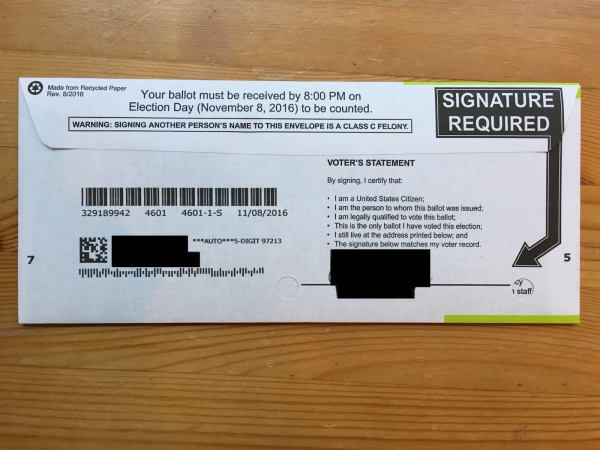
Fall is upon us, and therefore so is the 2024 presidential election. In Oregon, every registered voter will automatically get a ballot in the mail 14 to 18 days before the election, which they can then send via post or drop in an official ballot drop box. In person voting is also available by going to an official county election office any time during the voting period.
Though this system may sound normal, Oregon is in the minority when you look at how other states vote. Only eight states and Washington D.C. utilize vote by mail. The rest of the country has rules that vary widely by state, for example in some states you can only cast your ballot on election day, whereas in others voting begins as early as 50 days before an election.
In states without widespread vote by mail systems, if someone isn’t there to vote in person, voters can still request an “absentee ballot.” In some states there is “no excuse absentee voting,” which means that voters can request an absentee ballot without providing a reason. In other states you must provide an excuse to receive an absentee ballot, and this is where there can be issues.
Of the 14 states who require excuses for absentee ballots, nine don’t consider “working during all voting hours,” as a valid excuse to vote absentee. This particularly presents a challenge for low income workers, who often aren’t able to afford time off. It is also challenging for voters facing obstacles such as extreme weather, or not having easy access to transportation. While no excuse absentee voting is better than nothing, elections that are entirely vote-by-mail eliminate the need to repeatedly request absentee ballots and increase accessibility overall. Switching to vote-by-mail elections would allow voters who don’t have the ability to use polling locations to have an equal say in our democracy.
Evan Kost, former senior advisor to America Votes, highlights some of the benefits to vote-by-mail elections that may be less obvious. “It saves people time, avoids long lines at the polling locations, and it saves election officials money.” Additionally, Kost points out that “it gives voters more time to actually consider the issues and candidates [on] their ballot, as opposed to feeling rushed at the polling location.”
Not everyone feels that voting by mail is a good idea. Ben Edtl, a managing member at Politogy, claims that “Oregon has the worst election integrity in the nation, and vote-by-mail is part, but not all, of that equation.”
Statistical data does not back this claim up. According to a report done by the Oregon Legislative Fiscal Office in 2020, between the years 2000 and 2019 there were “38 criminal convictions for voter fraud out of the 60.9 million ballots in Oregon” which “amounts to a [fraud] rate of .00006%.” The report goes on to say, “These figures demonstrate that voter fraud is exceedingly rare in Oregon, and is no more widespread in vote-by-mail elections than it is in polling place elections.” This statement is backed up by data from the National Heritage Foundation, which in 2018 put the national voter fraud rate at .00007%. This is higher than Oregon’s.
Despite this, vote-by-mail still faces backlash. “Secure elections require three basic features,” says Edtl. “One, confirmation that a single person casts a single vote. Two, clean voter rolls, and three, transparent public oversight of the elections process. Oregon has none of those things.” Edtl claims that “confirming a single person casts a single vote is impossible.”
In actuality, to ensure one person only places one vote, states “have taken security measures to protect against vote by mail fraud,” says Kost. The Legislative Fiscal Office’s report backs this up, saying, “There are numerous processes built into Oregon’s vote by mail system to ensure integrity, including unique barcodes to track ballots, signature verification to prove voters’ identities, and election security plans filed by county elections offices. Vote by mail also leaves a paper trail that can be audited.”
Having “clean voter rolls” means that the list of people registered to vote in an area is accurate, meaning no one who moved away, died, or is otherwise ineligible, is on the list. In terms of “clean voter rolls,” as stated on Oregon’s Secretary of State website, “Oregon election officials regularly communicate and share information among each other and local, state, and federal partners to keep voter rolls clean … [t]his happens on an ongoing basis, year-round, to ensure that when we mail ballots, they go to an accurate list.”
To the last of Edtl’s points, he says a secure election requires “transparent public oversight of the elections process.” In addition to having easily accessible information, I fail to see how Oregon’s election process is different from any other state. Furthermore, it states on Oregon’s Secretary of State website that one can “Contact [their] county elections office to observe the election process.”
Vote-by-mail elections are convenient to voters for numerous reasons, with the main one being that it eliminates election day obstacles. Additionally, according to the Stanford Institute for Policy Research, there is no substantial benefit to either party. Voter turnout increases, but it increases the same amount for both parties. Though election results may take slightly longer in vote-by-mail elections, I believe it is worth waiting longer to count election results if it means the process is more democratic. Oregon has a vote-by-mail system that works great, providing equitable access to voting and high voter turnouts, thus more states around the country should transition to this system too.


































